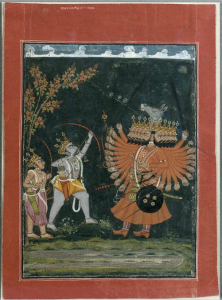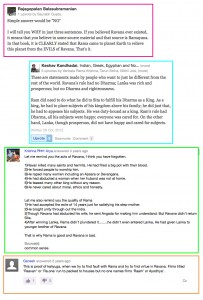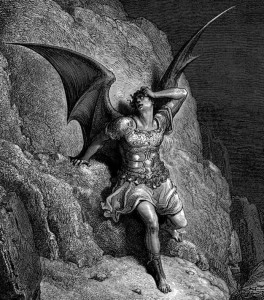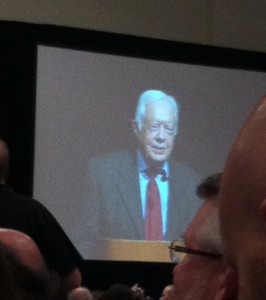This post originally appeared on the REL131: Studies in Hindu Traditions blog. An explanation, introduction, and justification for my class’ final research project can be found here (and also here).
_____________________________________
Complications Within a Feminist Sita
by Kathryn Meader
Sita is often heralded as the ideal woman, the ideal wife, and the ideal mother. A monumental and intimidating character, she is almost more central to the Ramayana than Rama himself. She is the mother of Rama’s children, and cares for them as the poet Valmiki recounts her story. When Sita arrives on the banks of the Ganga, Narada says to the poet, “Get up, save her life, and let her live here with you and your companions; and make in measured words the song of Rama”(Buck, 6). She frames the story, and she sculpts the story, all while still maintaining an outward appearance of a demure, submissive wife. The image of an ideal wife as dependent upon her husband is an attractive one to a mainly misogynistic society, but what happens when women take ownership of Sita as a role model? Do they see a demure, restrained woman, or is she transformed? In feminist readings of the Ramayana, Sita is still seen as an ideal for every woman to strive for, but she is far from quiet. She is fierce as she endures a trial by fire to prove her faithfulness, and is strong as she defies her husband when he asks her a second time to walk through the flames. In many ways, this moment within the text can be used as a focal point from which to see the various ways in which her image is manipulated popularly in both feminist and traditional reads of the text.
In Madhu Kishwar’s article, “Yes to Sita, No to Ram” she explores the popular understanding of Sita as a woman “whose sense of Dharma is superior to and more awe inspiring than that of Ram – someone who puts even maryada purushottam Ram – the most perfect of men – to shame”(Kishwar,1). This deeper read of Sita’s character is much more compelling than the simple, surface level understanding. She is not a meek woman who allows herself to be enslaved and mistreated by her husband. She is a fierce creature with a sense of pride and duty, whose rejection of Rama is the ultimate representation of dignity.
Looking at her actions within the Ramayana, one can open up the possibility for a feminist read of Sita that is at once empowering and quite complicated. It is complicated simply because if she is the ideal woman, and he the ideal man, how can the reader comprehend and rationalize the horrid mistreatment that Rama puts her through? In Linda Hess’s article “Rejecting Sita: Indian Responses to the Ideal Man’s Cruel Treatment of His Ideal Wife” she goes into an analysis of the various versions of the Ramayana and how these versions betray the cultural attitude towards Sita’s treatment, and what we can learn from these variations. She attempts to understand the issues involved with using such a complicated character as an image of empowerment, while she is simultaneously being used as an image of oppression.
Today more than ever before, Sita is a site of contestation. The Sita who clung to the dharma of worshiping her husband and bowing to his will, even when he repeatedly and cruelly rejected her, is still embraced as the ideal woman by many Hindus of both sexes. But others, increasingly, are describing that ideal as concocted by and serving the interests of dominant males from ancient times to the present. (Hess, 27-28)
The culminating moment of Sita’s story in the Ramayana comes during her trial by fire when she and Rama return victorious to Ayodhya. Her devotion to Ram is so complete that she is willing to walk to fire to prove that she had not touched or been touched by another man during her absence. His lack of faith in her, and unwillingness to prove to his people her innocence is what causes her eventual exile. This moment of Sita within the flames has been depicted countless times. Images have many layers of meaning, and every character in these depictions is giving us insight into the commentary of the artist. Sita is often shown serenely within the flames, with Agni by her side as Ram and Lakshman look on coldly. Hanuman is sometimes turned away from the sight. Each character is giving an opinion of the trial, as well as their opinion of Rama’s actions, through their body language.
In this popular depiction of the scene from c. 1895, Sita is as serene as ever, and the god Agni is faithfully by her side, but what is going on in the audience is very interesting. Rama is being restrained forcefully from entering the flames to save his love, while Hanuman shields his eyes (whether in aversion for the sight or disapproval of Ram, one cannot be sure). This version of the image is interesting because it illustrates the mixed feelings that Ram must have had about the ordeal for Sita. This image emphasizes the popular belief that Rama was wrong to exile her from the palace after she had proved herself to him, not to mention the fact that she was pregnant with twins. These opinions are not found within the text, and are a clear example of popular understanding of the story working its way into more widespread imagery.
Another important arena where a more feminist read of Sita flourishes is within the folk tradition of songs. In Rashmi Luthra’s article she goes into the connections between main female characters in the epics and the way they are represented in popular folk songs. The re-articulations within this setting create greater space for the elaboration and positioning of post-colonial Indian feminisms. The epics continue to be an important part of the cultural field and these appropriations are placed within the debate over the use of traditional narratives, in order to garner insight into the potential of the narratives as a resource for feminist projects. (Luthra, 35). Usha Zacharias is engaged in the same project of examining post-colonial feminisms in her article “Trial by Fire: Gender, Power, and Citizenship in Narratives of the Nation.” Zacharias moves between the development of Indian feminism and various instances of Sita’s character within the Ramayana, and serves to illustrate how Sita’s image is used to create the modern ideal of female citizenship. The ideal being pushed is that of a strong woman who stands up for herself, but also understands her place within the larger scheme.
Sita is a character that does not receive the development that she deserves within the text of the Ramayana. When she is understood in the hearts and minds of the readers, her personality and actions are elaborated in ways that are not always the way that the text intended. She can be used by the most traditional of men to set forth an example of their perfect, subordinate wife, while simultaneously being used as a rallying point for women who have had enough of their husbands. All who read her story carefully witness the strength within her character, but the way her image is employed in the popular arena illustrates the variations to be found within this ancient text.
Works Cited:
Buck, William, and B. A. van Nooten. Ramayana. Third Edition. Berkeley, Calif.; London: University of California Press, 2012.
Hess, Linda. “Rejecting Sita: Indian Responses to the Ideal Man’s Cruel Treatment of His Ideal Wife,” Journal of the American Academy of Religion, Vol 67. No. 1 (March, 1999).
Kishwar, Madhu. “Yes to Sita, No to Ram: The Continuing Hold of Sita on Popular Imagination in India,” in Questioning Ramayanas: A South Asian Tradition, ed. Paula Richman (Berkeley: University of California Press, 2001).
Luthra, Rashmi. “Clearing Sacred Ground: Women-Centered Interpretations of the Indian Epics,” Feminist Formations 26, no. 2 (2014): 135–61.
Zacharias, Usha. “Trial by Fire: Gender, Power, and Citizenship in Narratives of the Nation.” Social Text 19, no. 4 (2001): 29–51.
“Sita’s Ordeal by Fire.” British Museum. (Click on image above for link)











